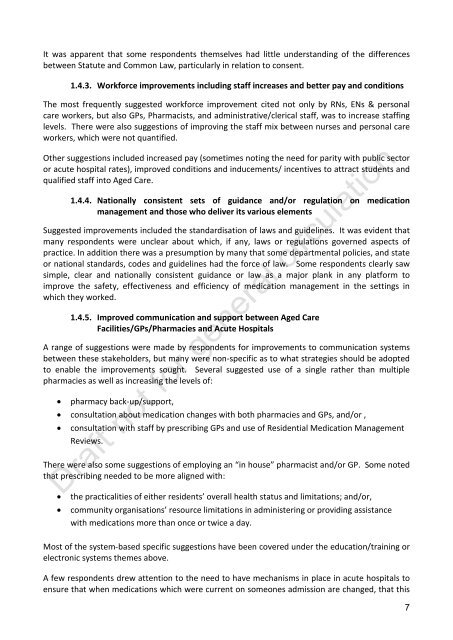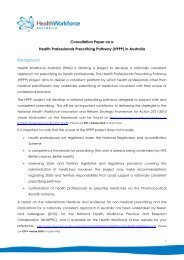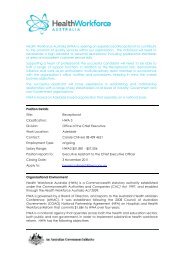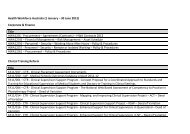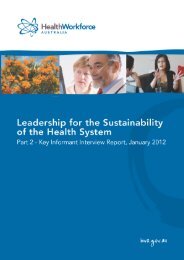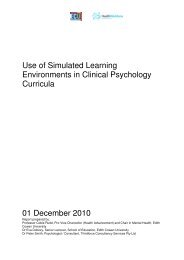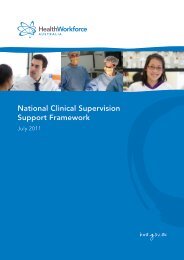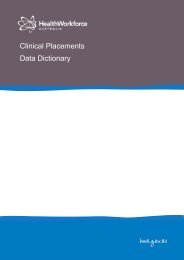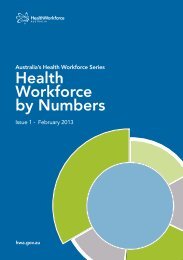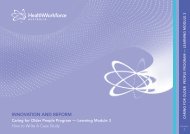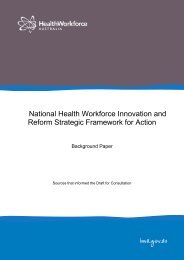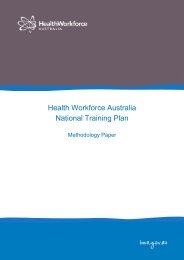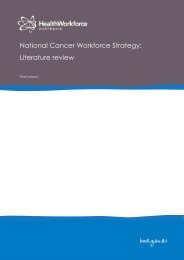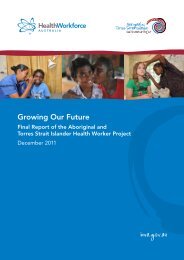SUMMARY - Safe Medications Management project: Key issues and ...
SUMMARY - Safe Medications Management project: Key issues and ...
SUMMARY - Safe Medications Management project: Key issues and ...
Create successful ePaper yourself
Turn your PDF publications into a flip-book with our unique Google optimized e-Paper software.
It was apparent that some respondents themselves had little underst<strong>and</strong>ing of the differencesbetween Statute <strong>and</strong> Common Law, particularly in relation to consent.1.4.3. Workforce improvements including staff increases <strong>and</strong> better pay <strong>and</strong> conditionsThe most frequently suggested workforce improvement cited not only by RNs, ENs & personalcare workers, but also GPs, Pharmacists, <strong>and</strong> administrative/clerical staff, was to increase staffinglevels. There were also suggestions of improving the staff mix between nurses <strong>and</strong> personal careworkers, which were not quantified.Other suggestions included increased pay (sometimes noting the need for parity with public sectoror acute hospital rates), improved conditions <strong>and</strong> inducements/ incentives to attract students <strong>and</strong>qualified staff into Aged Care.1.4.4. Nationally consistent sets of guidance <strong>and</strong>/or regulation on medicationmanagement <strong>and</strong> those who deliver its various elementsSuggested improvements included the st<strong>and</strong>ardisation of laws <strong>and</strong> guidelines. It was evident thatmany respondents were unclear about which, if any, laws or regulations governed aspects ofpractice. In addition there was a presumption by many that some departmental policies, <strong>and</strong> stateor national st<strong>and</strong>ards, codes <strong>and</strong> guidelines had the force of law. Some respondents clearly sawsimple, clear <strong>and</strong> nationally consistent guidance or law as a major plank in any platform toimprove the safety, effectiveness <strong>and</strong> efficiency of medication management in the settings inwhich they worked.1.4.5. Improved communication <strong>and</strong> support between Aged CareFacilities/GPs/Pharmacies <strong>and</strong> Acute HospitalsA range of suggestions were made by respondents for improvements to communication systemsbetween these stakeholders, but many were non-specific as to what strategies should be adoptedto enable the improvements sought. Several suggested use of a single rather than multiplepharmacies as well as increasing the levels of:pharmacy back-up/support, consultation about medication changes with both pharmacies <strong>and</strong> GPs, <strong>and</strong>/or ,consultation with staff by prescribing GPs <strong>and</strong> use of Residential Medication <strong>Management</strong>Reviews.There were also some suggestions of employing an “in house” pharmacist <strong>and</strong>/or GP. Some notedthat prescribing needed to be more aligned with:the practicalities of either residents’ overall health status <strong>and</strong> limitations; <strong>and</strong>/or,community organisations’ resource limitations in administering or providing assistancewith medications more than once or twice a day.Most of the system-based specific suggestions have been covered under the education/training orelectronic systems themes above.A few respondents drew attention to the need to have mechanisms in place in acute hospitals toensure that when medications which were current on someones admission are changed, that this7


